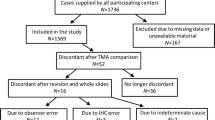Abstract
Steroid hormone receptor expression and HER2 status have become an integral part of histopathologic characterization of breast cancer and corresponding biomarker assays have gained important prognostic and predictive impact. Because testing inaccuracy could provide a major hazard to modern breast cancer therapy, a laboratory proficiency testing program has been implemented in Germany using tissue microarrays (TMAs). In four consecutive annual trials with 142 laboratories participating on average per trial, estrogen receptor (ER), progesterone receptor (PR), and human epidermal growth factor receptor 2 (Her2) were determined immunohistochemically by participating laboratories followed by central review of all immunostains. Performance strongly depended on the ambiguity of expression of the target molecule in the test samples. In clearly positive (Allred score 7–8; Her2 3+) or negative tissue samples, the majority of participants (86%) achieved concordance rates exceeding 85%. By contrast, low expression of ER or PR (Allred score 3–4) as well as Her2 status 2+ led to considerable lower concordance rates ranging from 41% (Her2 2+) to 75% (PR). Poor reproducibility was predominantly due to inadequate laboratory performance whereas interobserver agreement (weighted kappa statistics) usually was high (>0.81). Laboratories that participated in more than one of the four subsequent trials (n = 110) showed a highly significant improvement of performance. In conclusion, a TMA-based proficiency testing of biomarkers in breast cancer has been implemented in Germany over a 5-year period and revealed reliable assessment of unambiguously positive and negative test samples. Low-expressing tumor samples with regard to steroid hormone receptor expression and Her2 status 2+ led to inaccurate evaluations by up to 59% of participants. Regularly participating laboratories showed a significant improvement of performance.




Similar content being viewed by others
References
Goldhirsch A, Glick JH, Gelber RD et al (2005) Meeting highlights: international expert consensus on the primary therapy of early breast cancer 2005. Ann Oncol 16:1569–1583
Slamon DJ, Leyland-Jones B, Shak S et al (2001) Use of chemotherapy plus a monoclonal antibody against HER2 for metastatic breast cancer that overexpresses HER2. N Engl J Med 344:783–792
Carlson RW, Moench SJ, Hammond ME et al (2006) NCCN HER2 testing in Breast Cancer Task Force. HER2 testing in breast cancer: NCCN Task Force report and recommendations. J Natl Compr Canc Netw Suppl 3:S1–S22
Wolff AC, Hammond ME, Schwartz JN et al (2007) American Society of Clinical Oncology; College of America Pathologists. American Society of Clinical Oncology/College of American Pathologists guideline recommendations for human epidermal growth factor receptor 2 testing in breast cancer. J Clin Oncol 25:118–145
Ross JS, Symmans WF, Pusztai L et al (2007) Standardizing slide-based assays in breast cancer: hormone receptors, HER2, and sentinel lymph nodes. Clin Cancer Res 2007, 13:2831–2835
Viale G, Regan MM, Maiorano E et al (2007) Prognostic and predictive value of centrally reviewed expression of estrogen and progesterone receptors in a randomized trial comparing letrozole and tamoxifen adjuvant therapy for postmenopausal early breast cancer: BIG 1-98. J Clin Oncol 25:3846–3852
Rhodes A, Jasani B, Barnes DM et al (2000) Reliability of immunohistochemical demonstration of oestrogen receptors in routine practice: interlaboratory variance in the sensitivity of detection and evaluation of scoring systems. J Clin Pathol 53:125–130
Wells CA, Sloane JP, Coleman D et al (2004) Consistency of staining and reporting of oestrogen receptor immunocytochemistry within the European Union—an interlaboratory study. Virchows Arch 445:119–128
von Wasielewski R, Mengel M, Wiese B et al (2002) Tissue array technology for testing interlaboratory and interobserver reproducibility of immunohistochemical estrogen receptor analysis in a large multicenter trial. Am J Clin Pathol 118:675–682
Hsu FD, Nielsen TO, Alkushi A et al (2002) Tissue microarrays are an effective quality assurance tool for diagnostic immunohistochemistry. Mod Pathol 15:1374–1380
Allred DC, Harvey JM, Berardo M et al (1998) Prognostic and predictive factors in breast cancer by immunohistochemical analysis. Mod Pathol 11:155–168
Harvey JM, Clark GM, Osborne CK et al (1999) Estrogen receptor status by immunohistochemistry is superior to the ligand-binding assay for predicting response to adjuvant endocrine therapy in breast cancer. J Clin Oncol 17:1474–1481
Taylor CR, Levenson RM (2006) Quantification of immunohistochemistry—issues concerning methods, utility and semiquantitative assessment II. Histopathology 49:411–424
Swanson PE, Schmidt RA (2005) Beneath the surface of the mud, part II: the dichotomization of continuous biologic variables by maximizing immunohistochemical method sensitivity. Am J Clin Pathol 123:9–12
Diaz LK, Sneige N (2005) Estrogen receptor analysis for breast cancer: current issues and keys to increasing testing accuracy. Adv Anat Pathol 12:10–19
Layfield LJ, Goldstein N, Perkinson KR et al (2003) Interlaboratory variation in results from immunohistochemical assessment of estrogen receptor status. Breast J 9:257–259
Fitzgibbons PL, Murphy DA, Dorfman DM et al (2006) Interlaboratory comparison of immunohistochemical testing for HER2: results of the 2004 and 2005 College of American Pathologists HER2 Immunohistochemistry Tissue Microarray Survey. Arch Pathol Lab Med 130:1440–1445
Acknowledgements
The authors thank the numerous participants of the trials 2002–2006 for helpful and critical comments given in order to improve quality assurance trials in Germany.
Conflict of interest statement
R. von Wasielweski is founder and partial owner of the “Multiblock GmbH” which served as a logistics center in the 2006 trial.
Author information
Authors and Affiliations
Corresponding author
Additional information
Reinhard von Wasielewski and Svenja Hasselmann contributed equally to this work.
Rights and permissions
About this article
Cite this article
Wasielewski, R.v., Hasselmann, S., Rüschoff, J. et al. Proficiency testing of immunohistochemical biomarker assays in breast cancer. Virchows Arch 453, 537–543 (2008). https://doi.org/10.1007/s00428-008-0688-4
Received:
Revised:
Accepted:
Published:
Issue Date:
DOI: https://doi.org/10.1007/s00428-008-0688-4




